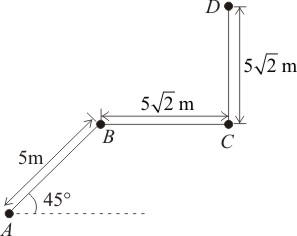1. statics
2. kinematics
3. mechanics
4. dynamics
| 1. | Both cannot be zero. |
| 2. | One of the two may be zero. |
| 3. | Both must be zero. |
| 4. | If one is positive, the other is negative, and vice-versa. |
A car moves with a speed of \(60\) km/h for \(1\) hour in the east direction and with the same speed for \(30\) min in the south direction. The displacement of the car from the initial position is:
| 1. | \(60\) km | 2. | \(30 \sqrt{2}\) km |
| 3. | \(30 \sqrt{5}\) km | 4. | \(60 \sqrt{2}\) km |
A particle moves along a path \(ABCD\) as shown in the figure. The magnitude of the displacement of the particle from \(A\) to \(D\) is:

1. m
2. \(10\) m
3. m
4. \(15\) m
A drunkard walking in a narrow lane takes \(5\) steps forward and \(3\) steps backward, followed again by \(5\) steps forward and \(3\) steps backward, and so on. Each step is \(1\) m long and requires \(1\) s. There is a pit on the road \(13\) m away from the starting point. The drunkard will fall into the pit after:
| 1. | \(37\) s | 2. | \(31\) s |
| 3. | \(29\) s | 4. | \(33\) s |
A boy throws a ball straight up the side of a building and receives it after \(4\) s. On the other hand, if he throws it so that it strikes a ledge on its way up, it returns to him after \(3\) s. The ledge is at a distance \(d\) below the highest point, where \(d=?\) (take acceleration due to gravity, \(g=10\) m/s2)
1. \(5\) m
2. \(2.5\) m
3. \(1.25\) m
4. \(10\) m
The distance travelled by a particle starting from rest and moving with an acceleration \(\frac{4}{3}\) ms-2, in the third second is:
1. \(6\) m
2. \(4\) m
3. \(\frac{10}{3}\) m
4. \(\frac{19}{3}\) m


